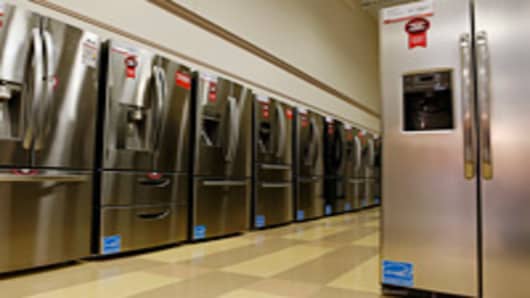Refrigerators today average 22.5 cubic feet, up from 19.6 cubic feet in 1980, according to the Association of Home Appliance Manufacturers.
Many proudly flaunt their capacity to store large pizza boxes and full size sheet cakes on their ample shelves.
While no empirical data exist that link larger appliances to the obesity epidemic in the U.S., the trend does enable a culture of excess, in which we buy more, eat more, and waste more than ever before, said Lisa Young, an adjunct professor of nutrition at New York University and author of “The Portion Teller.”
“Everything, especially our refrigerators, is bigger and when we have more space we buy more and make more food,” she said. “The theory is that you’ll save the leftovers and eat it later in the week, but that rarely happens.”
More often than not, said Young, the extra food becomes bigger portions, a significant factor in weight gain.
The latest data from the USDA’s Economic Research Service reveal the average number of calories Americans consume daily jumped to 2,604 in 2010 from 2,155 in 1970.
The average weight for American men age 20 and older also rose to nearly 195 pounds in 2006 from 166.3 pounds in 1960, while the average weight for women of the same age increased to nearly 165 pounds in 2006 from 140.2 pounds in 1960, according to the Centers for Disease Control and Prevention. (Read More:Fattest Cities.)
A third of adults in the U.S. are overweight, while 36 percent are considered obese, CDC data show.
The Second-Refrigerator Syndrome
Not everyone, of course, can afford the mega-sized professional grade refrigerators that are popular in high-end homes, some of which sell for upwards of $10,000.
But homeowners, especially those in rural and suburban areas, increasingly make room for extra ice cream and frozen lasagnas via the second fridge or freezer they keep in their basement or garage.
The Energy Department reports 22 percent of U.S. households have a second refrigerator, up from 12 percent in 1984.
Short-term studies confirm consumers consistently eat more when more is made available.
For example, a 2004 study by B.J. Rolls at Pennsylvania State University found that adults who were offered four different portion sizes of macaroni and cheese on different days ate more when offered the larger portion. Only 45 percent of the subjects reported noticing that there were differences in the size of the portions served.
To be fair, of course, consumers are free to stock their refrigerator shelves with healthy fare, too, but impulse control remains an elusive mistress for most, said Richard Wilk, an anthropology professor at Indiana University, who specializes in consumer culture.
“Impulse control is one of the hardest parts of dieting,” said Wilk. “When there are nine kinds of Haagen-Dazs in your freezer and a frozen Entenmann's cake, it makes it too easy to snack. Having a big refrigerator is like having a convenience store right in your house.”
That does not bode well for young adults, he notes, who increasingly opt to stay at home and communicate via social media outlets — close to their supply of chips and sugary soft drinks.
“It’s becoming clear that the next generation is having problems with sociability,” said Wilk. “A lot of them are more comfortable at home communicating by instant message, text, or Facebookthan they are actually talking to each other.”
The Warehouse-Club Effect
The proliferation of oversized and second refrigerators has been driven in part by the popularity of Costco ,Wal-Mart'sSam’s Club unit and other warehouse stores, where shoppers increasingly turn to stock their shelves with bulk food.
Psychologically, Young suggests such clubs compel members to buy enough to recoup their annual membership fee, and worse, consume what they buy before it goes bad.
“This encourages overconsumption,” said Young. “That’s OK for toilet paper, but it’s not a good idea for food. The more you buy, the more you tend to eat.”



